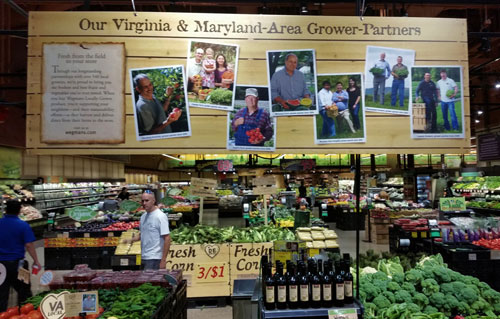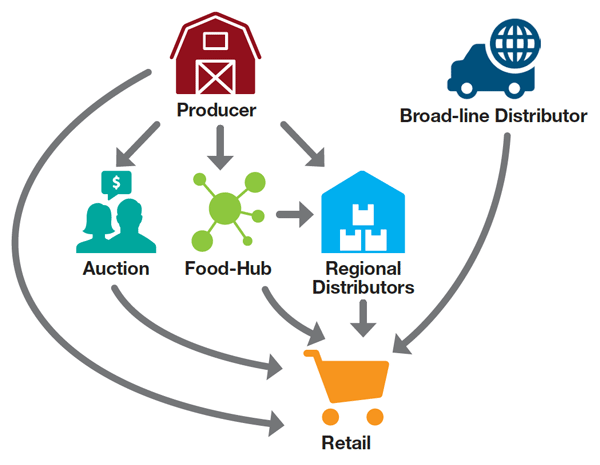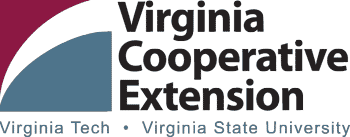Accessing Virginia’s Markets: Retailers
- Introduction
- Survey Findings
- Purchasing Priorities & Barriers
- Recommendations
- Producer Checklist
- Helpful Resources
Introduction
 The retail market sector often has the most convenient locations, longest duration of operating hours, and the lowest price (and therefore the most competitive price). Retail powerhouses that carry produce, such as Walmart and Target, purchase the goods they’re selling from wholesalers and sell those goods at a higher price. Clever, right? The main operating format for retailers is to sell directly to consumers rather than producers or intermediaries; note that there are several different types of retail markets.
The retail market sector often has the most convenient locations, longest duration of operating hours, and the lowest price (and therefore the most competitive price). Retail powerhouses that carry produce, such as Walmart and Target, purchase the goods they’re selling from wholesalers and sell those goods at a higher price. Clever, right? The main operating format for retailers is to sell directly to consumers rather than producers or intermediaries; note that there are several different types of retail markets.
The Specialty Crops Market News through the USDA surveys over 400 retailers, comprising over 30,300 individual stores, with online weekly advertised features in the nation. It’s important to note that just because a retailer supports local growing, there’s no guarantee that it’s as easy to enter as other markets. Local retail businesses such as Eats and Oasis, both located in Blacksburg, Virginia, support local growers since they are smaller scale operations that can rely largely on the local produce they purchase for their inventory. Other larger retailers, however, such as Kroger, often do supply local produce, but with the types of produce being limited given the number of consumers they provide for. While there are more opportunities in this sector relating to the number of retail markets, you have to know what the food requirements are. The Virginia Department of Agriculture and Consumer Services (VDACS) offers information on food safety regulations pertaining to each market sector, so be sure to read up on what applies to you as a potential retail supplier so you can understand and comply with what’s expected.
Survey Findings
In the survey we conducted to gain more insight into the involvement with local growers and retail markets, respondents mentioned that produce was purchased from distributors, food hubs, direct from growers, farmers markets, and food service providers. Some respondents were principal buyers; all were in charge of creating policies and procedures related to the procurement of fresh produce. Most respondents reported purchasing produce daily during the peak season as well as the remainder of the year, whereas others reported buying weekly all year long. Most respondents were unfamiliar with the Food Safety Modernization Act (FSMA). Of those who were familiar with the FSMA, they were not sure how it affected their organization. None of the respondents anticipated their food safety requirements changing as a result of the act. Overall, be aware of the type of retailer (independent vs. chain stores) and their readiness, or willingness to source locally. This includes corporate policies as well as size limitations of the produce being sold. Just because some retailers are larger does not mean they will not source locally, but it is imperative that the local growers effectively communicate with their respective buyers.
Purchasing Priorities & Barriers
Priorities
- Availability
- Quality
- Price
- Quantity/Volume
- Product Variety and Diversity
Barriers
- Grower Lack of Understanding of Buyer Requirements
- Delivery Capabilities (Timing, Flexibility, etc.)
- Product Consistency (Quality, Size, etc.)
- Lack of Intermediaries (Food Hubs, etc.)
- Insufficient Volume of Product
- Cost of Product
- Build relationships with purchaser and establish a regular communication schedule that takes into account the daily work-flow at the retail operation.
- Be aware of the type of retailer (i.e. independent vs. chain stores) and their readiness to source locally. This includes corporate policies as well as size limitations of the produce being sold. Just because some retailers are larger does not mean they will not source locally. However, these stores typically do require liability insurance and food safety certifications, so make sure to ask about vendor requirements.
- Remember that it is likely retailers would increase purchasing Virginia-grown produce if more producers met food safety requirements. At minimum, it is important to have training and a written food safety plan in place to demonstrate your awareness of the importance of food safety, and your commitment to produce quality and freshness.
- Make sure you are familiar with the Food Safety Modernization Act (FSMA) Produce Safety Rule (PSR) regulations and how they affect you as a producer. In many cases, retailers may want you to receive PSR training, along with meeting any GAP certification requirements.
- Telling your story is a great marketing technique, such as providing farm photographs, product information, and personal insights into your farming operation and what sets you apart. This information can be used by the retailer to add to the marketability of your product.
- Marketing yourself through a distributor may mitigate challenges presented by selling directly to the retailer, such as storage, temperature control, and transportation, especially since deliverability between the producer and retailer is often inefficient.
- Given VDACS statewide support for farming businesses, they might be able to serve as a middle point between producers and restaurants.
- It could be helpful to have a real-time statewide database of producers, which includes producer inventory and delivery capability. This would allow for more effective communication between both parties on the product being sold.
- Is the retailer independent or part of a regional or national chain?
- Does the retailer advertise its interest in sourcing locally grown produce? If so, who is the point of contact for purchasing your product—is the person located locally/regionally or at a corporate headquarters?
- What food safety policies does the retailer have? Do they require a 3rd party food safety audit, such as Good Agricultural Practices (GAP) certification? If so, which specific audit scheme is required (USDA GAP, Harmonized GAP, other)?
- Are there other food safety considerations that your buyer requires, such as a HACCP (Hazard Analysis and Critical Control Point) plan implemented in your operation?
- If training and/or audits are required, does the retailer provide any sort of incentive or cost share to support producers?
- Have you considered acquiring a certification such as Certified Organic or fair trade in order to boost your marketability?
- What are their needs in terms of volume and product characteristics, handling such as pre-washing, storage, and transport, and delivery schedule? Are you able to meet all these needs?
- Have you considered using a local food-hub or other intermediaries to alleviate possible logistic issues such as transport or meeting volume needs?

Helpful Resources
Accessing Virginia’s Retail Market Sector: Fresh Produce Food Safety Considerations Factsheet
Grower’s Manual: A Template for Grower Cooperatives
Guidance on standards for pre-harvest and post-harvest practices and product specifications used with local foodservice establishments.
National Retail Report - Specialty Crops
Advertised prices for specialty crops at major retail supermarket outlets.
Virginia Department of Agriculture and Consumer Services (VDACS)
The Virginia Department of Agriculture and Consumer Services (VDACS) administers a variety of Virginia laws and regulations that protect consumers and businesses.
Virginia Market Maker
The Market Maker portal is the largest and most in-depth national database for the agricultural industry. The portal provides a simple search tool to connect buyers, farmers/ranchers, fisheries, farmers markets, processors/packers, wineries, restaurants and more.
Wholesale and Retail Product Specifications: Guidance and Best Practices for Fresh Produce
A publication developed by the North Carolina Growing Together Project to provide small farms and food hubs with guidance on common product specifications to sell into wholesale and retail markets.
